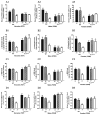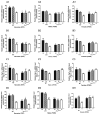Evidence for possible period 2 gene mediation of the effects of alcohol exposure during the postnatal period on genes associated with maintaining metabolic signaling in the mouse hypothalamus
- PMID: 22823489
- PMCID: PMC3480963
- DOI: 10.1111/j.1530-0277.2012.01871.x
Evidence for possible period 2 gene mediation of the effects of alcohol exposure during the postnatal period on genes associated with maintaining metabolic signaling in the mouse hypothalamus
Abstract
Background: Animals exposed to alcohol during the developmental period develop circadian disturbances and metabolic problems that often persist during their adult period. In order to study whether alcohol and the circadian clock interact to alter metabolic signaling in the hypothalamus, we determined whether postnatal alcohol feeding in mice permanently alters metabolic sensing in the hypothalamus. Furthermore, we evaluated whether the effect of circadian disruption via Period 2 (Per2) gene mutation prevents alcohol's effects on metabolic signaling in the hypothalamus.
Methods: Per2 mutant and wild-type male and female mice of the same genetic background were given a milk formula containing ethanol (EtOH; 11.34% vol/vol) from postnatal day (PD) 2 to 7 and used for gene expression and peptide level determinations in the hypothalamus at PD7 and PD90.
Results: We report here that postnatal alcohol feeding reduces the expression of proopiomelanocortin (Pomc) gene and production of β-endorphin and α-melanocyte stimulating hormone (α-MSH) in the hypothalamus that persists into adulthood. In addition, expressions of metabolic sensing genes in the hypothalamus were also reduced as a consequence of postnatal alcohol exposure. These effects were not sex-specific and were observed in both males and females. Mice carrying a mutation of the Per2 gene did not show any reductions in hypothalamic levels of Pomc and metabolic genes and β-endorphin and α-MSH peptides following alcohol exposure.
Conclusions: These data suggest that early-life exposure to alcohol alters metabolic sensing to the hypothalamus possibly via regulating Per2 gene and/or the cellular circadian clock mechanism.
Copyright © 2012 by the Research Society on Alcoholism.
Figures


Similar articles
-
Fetal alcohol exposure disrupts metabolic signaling in hypothalamic proopiomelanocortin neurons via a circadian mechanism in male mice.Endocrinology. 2014 Jul;155(7):2578-88. doi: 10.1210/en.2013-2030. Epub 2014 May 5. Endocrinology. 2014. PMID: 24797626 Free PMC article.
-
Period 2 gene deletion abolishes beta-endorphin neuronal response to ethanol.Alcohol Clin Exp Res. 2010 Sep 1;34(9):1613-8. doi: 10.1111/j.1530-0277.2010.01246.x. Epub 2010 Jun 25. Alcohol Clin Exp Res. 2010. PMID: 20586752 Free PMC article.
-
Adolescent binge-like ethanol exposure reduces basal α-MSH expression in the hypothalamus and the amygdala of adult rats.Pharmacol Biochem Behav. 2013 Sep;110:66-74. doi: 10.1016/j.pbb.2013.06.006. Epub 2013 Jun 20. Pharmacol Biochem Behav. 2013. PMID: 23792540 Free PMC article.
-
Prenatal ethanol exposure alters the expression of period genes governing the circadian function of beta-endorphin neurons in the hypothalamus.J Neurochem. 2006 May;97(4):1026-33. doi: 10.1111/j.1471-4159.2006.03839.x. J Neurochem. 2006. PMID: 16686691
-
Ethanol-activated microglial exosomes induce MCP1 signaling mediated death of stress-regulatory proopiomelanocortin neurons in the developing hypothalamus.J Neuroinflammation. 2024 Oct 30;21(1):279. doi: 10.1186/s12974-024-03274-6. J Neuroinflammation. 2024. PMID: 39478585 Free PMC article.
Cited by
-
Fetal alcohol exposure disrupts metabolic signaling in hypothalamic proopiomelanocortin neurons via a circadian mechanism in male mice.Endocrinology. 2014 Jul;155(7):2578-88. doi: 10.1210/en.2013-2030. Epub 2014 May 5. Endocrinology. 2014. PMID: 24797626 Free PMC article.
-
Altered circadian expression of clock genes and clock-regulatory epigenetic modifiers in saliva of children with fetal alcohol spectrum disorders.Sci Rep. 2024 Aug 27;14(1):19886. doi: 10.1038/s41598-024-71023-z. Sci Rep. 2024. PMID: 39191924 Free PMC article.
-
miRNA-383 and miRNA-384 Suppress Proopiomelanocortin Gene Expression in the Hypothalamus: Effects of Early Life Ethanol Exposure.Neuroendocrinology. 2023;113(8):844-858. doi: 10.1159/000530289. Epub 2023 Mar 22. Neuroendocrinology. 2023. PMID: 36948162 Free PMC article.
-
Circadian rhythms and addiction: mechanistic insights and future directions.Behav Neurosci. 2014 Jun;128(3):387-412. doi: 10.1037/a0036268. Epub 2014 Apr 14. Behav Neurosci. 2014. PMID: 24731209 Free PMC article. Review.
-
Clock genes × stress × reward interactions in alcohol and substance use disorders.Alcohol. 2015 Jun;49(4):351-7. doi: 10.1016/j.alcohol.2015.04.003. Epub 2015 Apr 24. Alcohol. 2015. PMID: 25943583 Free PMC article. Review.
References
-
- Ando H, Takamura T, Matsuzawa-Nagata N, Shima KR, Eto T, Misu H, Shiramoto M, Tsuru T, Irie S, Fujimura A, Kaneko S. Clock gene expression in peripheral leucocytes of patients with type 2 diabetes. Diabetologia. 2009;52:329–335. - PubMed
-
- Appleyard SM, Hayward M, Young JI, Butler AA, Cone RD, Rubinstein M, Low MJ. A role for the endogenous opioid beta-endorphin in energy homeostasis. Endocrinology. 2003;144:1763–1760. - PubMed
-
- Arjona A, Boyadjieva N, Kuhn P, Sarkar DK. Fetal ethanol exposure disrupts the daily rhythms of splenic granzyme B, IFN-gamma, and NK cell cytotoxicity in adulthood. Alcohol Clin Exp Res. 2006;30:1039–1044. - PubMed
-
- Baker M, Gaukrodger N, Mayosi BM, Imrie H, Farrall M, Watkins H, Connell JMC, Avery PJ, Keavney B. Association between common polymorphisms of the proopiomelanocortin gene and body fat distribution. Diabetes. 2005;54:2492–2496. - PubMed
Publication types
MeSH terms
Substances
Grants and funding
LinkOut - more resources
Full Text Sources
Miscellaneous

